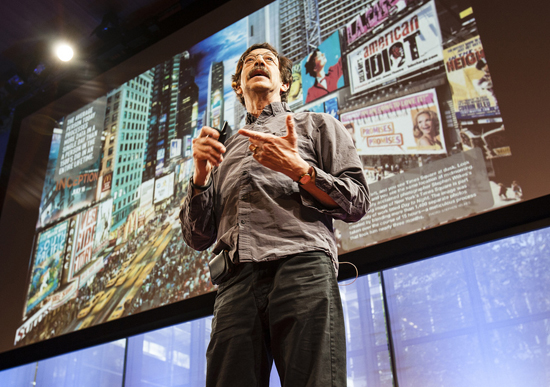Teen reporters Sadie Cruz and Nia Ashley conducted lots of interviews with speakers at the TEDYouth conference on November 17. Their Q&As will run on the TED Blog over the next few weeks. Here, a interview conducted by Sadie.
Photographer Rick Smolan brought the flavor of homes across the United States to life, helped 25,000 photographers capture the spirit of American life minute-by-minute and cofounded A Day in the Life books, an ‘80s cultural touchstone. Smolan’s new project, The Human Face of Big Data, is about information in our world today. It’s just the latest in his long career, which began at age 16.
At TEDYouth, Rick spoke with me about his road to success, as well as what it’s like to be an amateur, a professional and the big, bad editor all in one.
Sadie Cruz: What drew you to be a photographer?
Rick Smolan: I was painfully shy when I was a kid. I always thought when most people were born, part of the toolkit was teaching you how to relate to other people — and it was just left out of my toolkit. So I sort of thought if I kept watching other people enough, and hung out close enough to them, I could figure out how they did it. Having a camera was a great excuse to kind of be there but not be there.
SC: Which project is your favorite, and why?
RS: The Human Face of Big Data has been by far the most challenging, and now the most satisfying, of any project I’ve ever done, because I think that we’re trying to start a global conversation about big data.
SC: So, how did that book start out?
RS: A friend of mine, Marissa Mayer, is the CEO of Yahoo, and I’ve known her for a long time. She said, “You should look at the world of big data.” And I said, “What’s that?” She started explaining it to me, and she said, “It’s like watching the planet develop a nervous system. All of us have become human sensors, with our phones and we’re all helping give this feedback loop that the human race has never had before.” So we started looking at it, thinking, how do you photograph that?
SC: If you weren’t a photographer, what would you be?
RS: Wow. You stumped me. This has been my whole life since I was 16, so it’s even hard to imagine. I’m not very good at science or math, even though I pretend. And I’m not very good at teaching. I’m not very patient. I don’t know the answer.
SC: Did you ever think you were going to be as successful as you are today?
RS: No, never. My dad was actually against me being a photographer. He thought it was a dead-end job and that you end up doing baby pictures and weddings. He told me I was being totally unrealistic because I wanted to work for Time magazine and National Geographic, and he said, “You never complete anything. You never finish any job. How could you ever work for these great magazines?” And I don’t know, somehow it happened.
SC: So when was that moment that you turned from amateur to professional?
RS: I don’t think it ever happened, because amateur means something you love, and I still really love what I do. Now I mostly photograph my kids, and I hire the best photographers in the world to work on my projects, so I sort of have the best of both worlds. But all of my friends who were really great professional photographers, they always had one camera which was their job camera and one camera which was their personal camera. So while they were shooting their assignment, they were also shooting personal pictures the whole time.
SC: How have cameras evolved from when you started to now?
RS: Oh, it’s so different now. I mean, the idea that we used to carry rolls of film around, and that when you got to 36, you had to stop for two minutes to change the roll of film — or that maybe the film you were using had been baked in the truck and you didn’t know it — there were so many things that could go wrong.
Now the fact that you can look down at the camera and see the results instantly, it’s called “chimping.” What they say is, while you’re chimping, you’re missing shots. Because instead of shooting, you keep reviewing what you’ve just done while the stuff keeps happening out there.
SC: Have you ever found any bizarre pictures that make you say, “oh no, we cannot put that in the book?”
RS: Oh, sure. You see a lot of things like that. I mean, what amazes me is that you can have 10 different photographers in the same room and you see 10 different rooms. You realize how much of it is the person’s perspective, rather than the situation itself. So I love hiring photographers who can be in a pack of a thousand photographers and they always come back with something very distinctive.
The hard part for me when I do my project is that I can’t be fair to every photographer, so even though we hire people, there’s no guarantee they’ll get a picture in the book. I feel like I’ve become the bad editor that I used to hate when I was the photographer, but we have to do what’s best for telling the story of the book. So sometimes there’ll be a kid on our staff who’s an intern, and he or she will get a better picture than one of our Pulitzer Prize-winning photographers. That’s just how it works.

Comments (3)
Pingback: The Medium Is The Message, 50 Years Later | The Today Online
Pingback: The Medium Is The Message, 50 Years Later | The Medium Is The Message, 50 Years Later | Social Dashboard